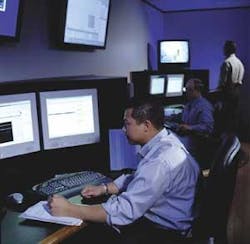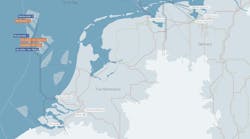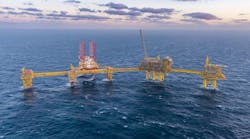Judy Maksoud
International Editor
Varco International has developed a way to reduce rig downtime by monitoring drilling equipment in near real-time. The system is called e-drill, a product the company describes as the industry's first system for remotely monitoring and diagnosing Varco equipment on rigs anywhere in the world.
E-drill supplies data via an Internet link to a manned service center based in Houston, Texas. The center offers remote diagnostics in the form of trained technicians and engineers who monitor rig activities 24 hours a day. The staff communicates monitoring, maintenance, and trouble- shooting information to the working rig, allowing drilling companies to maximize equipment operation and minimize downtime.
Proactive monitoring
The e-drill service center is manned 24 hours a day by experts who have controlled electronic access to the rig's control system. This access allows technicians to proactively monitor more than 5,000 data points on Varco equipment, from pipe-racking and iron roughneck systems on the drilling floor to mud pump-monitoring sensors.
"The manned center provides an infrastructure behind the technology," explained Lance Suvans, manager of Varco's e-drill service center.
The primary product that e-drill delivers is information. The data gathered during monitoring and troubleshooting is shared via Internet connection, giving near real-time access to rig equipment data. This information can be used to direct drilling related activity and to analyze and help maintain drilling equipment.
One of e-drill's primary objectives is to achieve optimum drilling performance while preventing minor setbacks from escalating into significant events that necessitate rig downtime. Because technicians are actively monitoring rig data, they are able to isolate problems efficiently. When a problem is identified, a Varco technician or engineer contacts the rig to analyze, troubleshoot, or advise that a maintenance activity should be scheduled.
The system operates on what Suvans called a "break/fix concept." Varco is able to identify problem areas quickly and to direct workers on the rig to rectify setbacks so that normal operations can resume. Simply put, e-drill revives operations when, or even before, technical problems bring them to a halt.
The system at work
E-drill cuts costs in a number of ways. The system provides trend reports, event records, rig activity surveys, training aids, and call logs that help rig operators streamline activities and troubleshoot equipment. By monitoring equipment around the clock, service personnel can ensure optimum performance while preventing small issues from becoming big expenses.
Varco has developed a Web page for each user. The Web site shows daily equipment health and performance, communications, problems that have been identified, and action items being undertaken. Password-protected access is provided so that rig managers and operators can view critical information whenever necessary. The interaction and communication between the rig maintenance personnel and the service center creates an avenue for shared technical information.
The fact that equipment can be constantly monitored means that operational problems can be isolated quickly. "We can see when operators are operating equipment incorrectly," said Suvans. And by knowing where inefficiencies exist, Varco can suggest corrective action.
In one instance, an operator of a pipe-racking system was using the override excessively. The pipe-racking system could work, but the system wasn't being used to its greatest capacity. When the problem was identified by e-drill support staff and a solution implemented, the pipe-racking could be carried out more efficiently.
The main benefit for rig operators is that e-drill provides immediate response when a problem surfaces in the form of equipment failure. In the past, this sort of problem would have been handled by a service engineer flying to the rig from shore to fix the problem. E-drill saves time by allowing experienced service people to troubleshoot from shore using data collected directly from equipment on the rig.
Implementing the system
Helmerich & Payne developed e-drill in partnership with Varco and was the first company to use the system. The company currently has 13 rigs outfitted with e-drill.
Varco's showcase service center opened in Houston in January 2002 and initially offered support for H&P's rigs. Now, e-drill has moved from land to a marine environment, with 15 offshore rigs being monitored as of September.
Transocean was the first offshore drilling contractor to purchase the system, with the Discoverer Deep Seas becoming the first offshore drilling rig to use e-drill.
"The reason we have e-drill on the rig is that we have limited vendor software and electronic resources to call upon when something goes wrong," explained Eddy Redd, rig manager for Transocean's Discoverer Deep Seas. If the problem involves the control logic or software, the rig crew is at a disadvantage. Software problems have historically resulted in downtime, primarily because software expertise is specialized knowledge. Redd sees value in the resources offered by e-drill on a 24-hour basis because the specialized knowledge goes beyond the knowledge pool available on a rig.
"We're very good on the rig at fixing things and making things work, but we don't always have the information to identify what caused the problem," Redd explained.
When a problem surfaces, e-drill helps to identify the cause, which enables the driller to avoid a repeat occurrence or to recognize when a problem recurs and resolve it more rapidly.
According to Transocean, a four-month pilot of the e-drill system saved the Discoverer Deep Seas several hours of downtime. The system's success led Transocean to select seven additional ultra-deepwater drilling rigs to receive e-drill service.
By yearend, the Discoverer Spirit, Discoverer Enterprise, Cajun Express, Deepwater Nautilus, Deepwater Horizon, Deepwater Pathfinder, and Deepwater Millennium also will be outfitted with the e-drill system.
Return on investment
The value of e-drill, said Redd, will be fully realized over time. Initially, the system has simplified problem resolution and has prevented prolonged downtime. But the greatest value of the system is not immediate. "The real value we feel we will get is yet to come," Redd said. That value will come from making comparative studies on rig operations. By determining standard operation times for day-to-day rig activities, Transocean can improve rig efficiency across the board. "The optimization stage will bring greater returns on investment," Redd said.
There is also a longer-term "third stage" in getting value from the system, Redd explained. As a manufacturer, Varco has designed drilling equipment to meet the industry's needs. Sometimes, the equipment does the job, but doesn't work exactly as design engineers intended or as drillers would prefer. The communication e-drill facilitates between drillers and design and software engineers could well result in improved rig equipment that includes features and enhancements that improve drilling operations. In the end, improved equipment could be e-drill's biggest impact on the offshore drilling industry, Redd said.
Software goals
With e-drill up and running, Varco is now working toward an expert software (condition monitoring), Suvans said. The plan is to incorporate sensors in the equipment that will indicate when a part is likely to fail. This moves the service "from proactive maintenance to predictive maintenance," he said. Suvans says the company is planning to use QC test data to predict part failure to allow planned maintenance instead of emergency maintenance on working rigs. The end result will be the ability to carry out maintenance during down time instead of stopping operations to replace worn parts.






